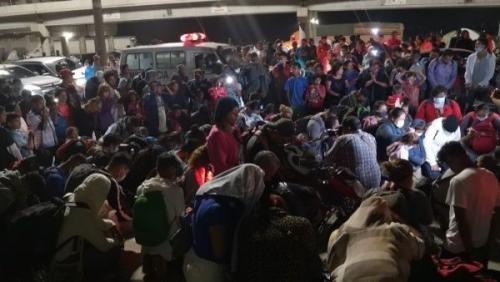Honduras: Caravan of the Damned
Prior to the hurricanes, OCHA estimated that Honduras and Guatemala already had a combined 4.6 million people in need.
- Información

Over 500 people who lost everything in Hurricanes Eta and Iota set out from the San Pedro Sula bus station on Thursday, December 10, 2020. Calling themselves the “Caravana de los damnificados”, they intend to walk, hitch, ride or somehow make their way to Mexico, and then, to the United States. Other groups are organizing themselves to leave Honduras in January.
“Damnificado” in Spanish refers to victims of a disaster such as a storm, flood or fire, but the name is also evocative of the suffering experienced by people who have lost everything. Two record-shattering hurricanes affected 7.3 million people in the region, according to the United Nations Office for the Coordination of Humanitarian Affairs (OCHA). Prior to the hurricanes, OCHA estimated that Honduras and Guatemala already had a combined 4.6 million people in need.
Hurricane Eta struck the northeastern corner of the Miskito Coast, just south of where Honduras meets Nicaragua, on November 3rd, 2020 as a Category 4 storm. Eta was followed two weeks later by Hurricane Iota, which measured Category 5, the highest level on the Saffir-Simpson Hurricane Wind Scale. Eta hit the same area, centered a mere 15 miles south.
More than 300 people, many of them women and children, are marooned at the Guatemalan border. Guillermo Díaz, general director of the Guatemala Migration Institute, expressed concern about the number of women and children, saying that minors represent an even greater percentage of walkers than in past caravans. “Something of interest making this caravan significantly different from past ones is the number of children. The number of children and adolescents is extremely high, forcing us to be more careful about the interests and human rights of participants.”
Referring to protocols in place to control the spread of the Covid-19 virus at the border, Mr Díaz said that while no one has yet to enter Guatemala, the situation is “very complicated”.
Almost everyone in the group, including the small children, appears to be wearing a mask. Most are dressed in plain sweatshirts and jeans and carrying simple backpacks. Guatemala now requires all foreigners over the age of 10 to present a current negative Covid test less than 96 hours prior to arrival at its border and then quarantine for 10 days. Wearing face masks in public is mandatory.
Two months ago, an earlier caravan of Hondurans was repulsed by the Guatemala military, in accordance with agreements made between the government of Guatemalan President Alejandro Giammattei and the United States. Giammattei, who was elected in January 2020 but has not proven a popular president, is an ultra conservative, formerly the director of the country’s prison system. The Trump administration cut off financial aid to the country in 2019, only resuming this year contingent upon stricter border control.
But apparently that compliance was not good enough. In his last weeks in office, U.S. President Trump vetoed a financial assistance bill that would have provided Americans with $600 each. One of the components of the bill he objected to was foreign aid specifically to Central America.
The number of hurricane deaths in Honduras has been grossly underreported, according to an investigation carried out by independent news magazine Contracorriente. Dr Julissa Villanueva, former director of forensic medicine, claims the government is leaving the mission of reporting casualties up to local communities who are ill-equipped to carry out the work. “How many hundreds of deaths were caused by the hurricanes and need to be buried, and nobody is interested in discovering that figure until they are all left behind and forgotten,” she explained.
Canadian t-shirt and activewear manufacturer Gildan, a major employer in Honduras, has had to shut half its factories in the country due to the hurricane, moving work to Barbados and other countries. According to Canadian newspaper The Globe and Mail, because Gildan maintains an office in Barbados, the company has managed to elude paying corporate income tax in Canada. From 2009 to 2013, the article states, the company paid only 1% in taxes.
Gildan employed 26,000 workers in Honduras, while maintaining only some 200 employees in Canada. Gildan refused to reveal the wages it pays in Honduras to The Globe and Mail, citing “competitive information”. But the newspaper discovered that Honduran trade unions estimate the workers there earn an average of $351 a month, working four 11 hour shifts a week. That’s above the $283 minimum wage established in the government’s free trade zone, where Gildan’s facilities are located.
But it’s far below the amount that Washington DC-based organization Workers’ Rights Consortium (WRC) estimates to be a living wage in Honduras, $683 a month. Their report also details numerous labor violations by the company.
One of the hardest hit regions in Honduras is the Valle de Sula, an industrial and agricultural zone that produces over 65% of the country’s GDP. NGO’s such as CARE and the Famine Early Warning System Network (FEWS NET) are reporting serious impending food shortages.
December 28, 2020
https://zcomm.org/znetarticle/honduras-caravan-of-the-damned/
Del mismo autor
- El icónico glaciar mexicano Ayoloco ya no existe 29/04/2021
- Venezuela envía oxígeno y médicos a la Amazonía brasileña 21/01/2021
- Venezuela sends oxygen and doctors to Brazilian Amazon 20/01/2021
- France grants citizenship to immigrant essential workers 06/01/2021
- La caravana de los damnificados 29/12/2020
- Honduras: Caravan of the Damned 28/12/2020
- La policía abre fuego sobre protesta contra el feminicidio en Cancún 16/11/2020
- Police Fire on Femicide Protest in Cancún 14/11/2020
- To Our Confederate Dead: Take It Down! 21/06/2020
- Police fire at queer bar owner during protests on first day of Pride 03/06/2020








